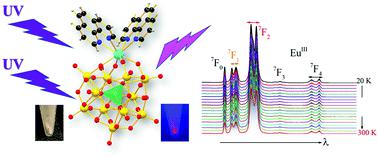当前位置:
X-MOL 学术
›
Inorg. Chem. Front.
›
论文详情
Our official English website, www.x-mol.net, welcomes your
feedback! (Note: you will need to create a separate account there.)
A systematic study of the optical properties of mononuclear hybrid organo–inorganic lanthanoid complexes
Inorganic Chemistry Frontiers ( IF 6.1 ) Pub Date : 2020-04-30 , DOI: 10.1039/d0qi00232a Matias Zapata-Lizama 1, 2, 3, 4, 5 , Patricio Hermosilla-Ibáñez 1, 2, 3, 4, 5 , Diego Venegas-Yazigi 1, 2, 3, 4, 5 , Guillermo Mínguez Espallargas 6, 7, 8, 9 , Lauro June Queiroz Maia 10, 11, 12, 13 , Gisane Gasparotto 10, 11, 12, 13 , Ricardo Costa De Santana 10, 11, 12, 13 , Walter Cañón-Mancisidor 1, 2, 3, 4, 5
Inorganic Chemistry Frontiers ( IF 6.1 ) Pub Date : 2020-04-30 , DOI: 10.1039/d0qi00232a Matias Zapata-Lizama 1, 2, 3, 4, 5 , Patricio Hermosilla-Ibáñez 1, 2, 3, 4, 5 , Diego Venegas-Yazigi 1, 2, 3, 4, 5 , Guillermo Mínguez Espallargas 6, 7, 8, 9 , Lauro June Queiroz Maia 10, 11, 12, 13 , Gisane Gasparotto 10, 11, 12, 13 , Ricardo Costa De Santana 10, 11, 12, 13 , Walter Cañón-Mancisidor 1, 2, 3, 4, 5
Affiliation

|
A series of hybrid organo–inorganic mononuclear lanthanoid complexes, [n-NBu4]3[LnH(PW11O39)(phen)2]·H2O, denoted as LM4-1-Ln (Ln = DyIII, TbIII, EuIII, NdIII, ErIII, HoIII and GdIII), were synthesized via hydrothermal synthesis and were structurally characterized by X-ray diffraction. The optical properties of all complexes have been investigated in the solid state. The temperature-dependent emission spectra of LM4-1-Dy, LM4-1-Tb and LM4-1-Eu complexes show intense lanthanoid emissions in the visible region, while LM4-1-Nd shows near-infrared (NIR) luminescence. The EuIII complex shows typical strong red emissions from the 5D0 → 7F0,1,2,3,4 transitions, with the CIE colour coordinates (0.631,0.364), the colour purity value of 83.9% and a quantum yield of up to 4.3%, suggesting that the organic fragment has an effect on the optical properties compared to fully inorganic systems, making this complex very attractive as a red component of light-emitting diodes. The luminescence decays of LM4-1-Dy, LM4-1-Tb and LM4-1-Eu exhibit a biexponential behaviour, with τAV = 4.1(7) μs, 0.35(2) ms and 0.94(3) ms, respectively. The values obtained for Judd–Ofelt intensity parameters Ω2 and Ω4 support the interaction between the EuIII and the ligands. Furthermore, those with ErIII and HoIII present weak emissions in the visible region. The T-dependent photoluminescence results show that the LM4-1-Dy, LM4-1-Tb and LM4-1-Nd complexes have good temperature sensitivity, demonstrating that the materials have the potential to be used as a sensing element for luminescent thermometers in different temperature ranges.
中文翻译:

对单核杂化有机-无机镧系元素络合物的光学性质的系统研究
一系列杂化的有机-无机单核镧系元素络合物[ n -NBu 4 ] 3 [LnH(PW 11 O 39)(phen)2 ]·H 2 O,表示为LM 4 -1-Ln(Ln = Dy III,铽III欧盟III,钕III,二III,何III和Gd III),合成通过水热合成,并通过X射线衍射对其结构进行表征。已经在固态下研究了所有配合物的光学性质。LM 4 -1-Dy,LM 4 -1-Tb和LM 4 -1-Eu配合物的温度相关发射光谱在可见光区域显示出强烈的镧系元素发射,而LM4-1-Nd显示近红外(NIR)发光。Eu III配合物显示出5 D 0 → 7 F 0,1,2,3,4典型的强红色发射过渡,具有CIE颜色坐标(0.631,0.364),色纯度值为83.9%,量子产率高达4.3%,这表明与完全无机的体系相比,有机碎片对光学性能有影响,这使得复合物作为发光二极管的红色成分非常吸引人。的发光衰变LM 4 -1-的Dy,LM 4 -1-Tb的和LM 4 -1-Eu的表现出双指数行为,与τ AV = 4.1(7)微秒,0.35(2)毫秒和0.94(3)毫秒, 分别。对于贾德-Ofelt理论强度参数获得的值Ω 2和Ω 4支持Eu III与配体之间的相互作用。此外,具有Er III和Ho III的化合物在可见光区域的发射微弱。T依赖的光致发光结果表明LM 4 -1-Dy,LM 4 -1-Tb和LM 4 -1-Nd配合物具有良好的温度敏感性,这表明该材料具有用作电子传感元件的潜力。不同温度范围内的发光温度计。
更新日期:2020-04-30
中文翻译:

对单核杂化有机-无机镧系元素络合物的光学性质的系统研究
一系列杂化的有机-无机单核镧系元素络合物[ n -NBu 4 ] 3 [LnH(PW 11 O 39)(phen)2 ]·H 2 O,表示为LM 4 -1-Ln(Ln = Dy III,铽III欧盟III,钕III,二III,何III和Gd III),合成通过水热合成,并通过X射线衍射对其结构进行表征。已经在固态下研究了所有配合物的光学性质。LM 4 -1-Dy,LM 4 -1-Tb和LM 4 -1-Eu配合物的温度相关发射光谱在可见光区域显示出强烈的镧系元素发射,而LM4-1-Nd显示近红外(NIR)发光。Eu III配合物显示出5 D 0 → 7 F 0,1,2,3,4典型的强红色发射过渡,具有CIE颜色坐标(0.631,0.364),色纯度值为83.9%,量子产率高达4.3%,这表明与完全无机的体系相比,有机碎片对光学性能有影响,这使得复合物作为发光二极管的红色成分非常吸引人。的发光衰变LM 4 -1-的Dy,LM 4 -1-Tb的和LM 4 -1-Eu的表现出双指数行为,与τ AV = 4.1(7)微秒,0.35(2)毫秒和0.94(3)毫秒, 分别。对于贾德-Ofelt理论强度参数获得的值Ω 2和Ω 4支持Eu III与配体之间的相互作用。此外,具有Er III和Ho III的化合物在可见光区域的发射微弱。T依赖的光致发光结果表明LM 4 -1-Dy,LM 4 -1-Tb和LM 4 -1-Nd配合物具有良好的温度敏感性,这表明该材料具有用作电子传感元件的潜力。不同温度范围内的发光温度计。











































 京公网安备 11010802027423号
京公网安备 11010802027423号